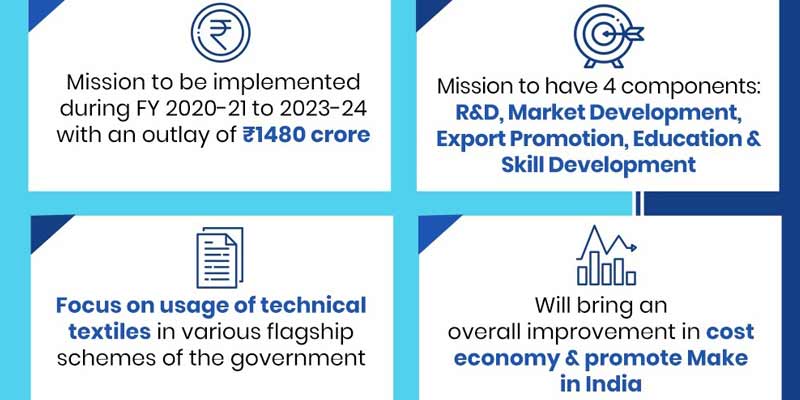- India
- Jan 18
Explainer / National Technical Textiles Mission
The textiles ministry cleared 20 strategic projects worth Rs 30 crore in the areas of speciality fibres and geo-textiles under the National Technical Textiles Mission.
The projects were approved at a meeting chaired by Textiles Minister Piyush Goyal.
The 16 projects of speciality fibres approved include five in healthcare, four in industrial and protective, three projects each in energy storage and textile waste recycling, and one project in agriculture, apart from four projects in geo-textiles (infrastructure).
In March 2021, as many as 11 research projects worth Rs 78.60 crore were cleared by the ministry.
Technical textiles
• Technical textiles are materials and products manufactured primarily for technical performance and functional properties rather than aesthetic characteristics.
• They are futuristic which are used for various applications ranging from agriculture, roads, railway tracks, sportswear, bulletproof jackets, fireproof jackets, high-altitude combat gear and space applications.
• Technical textiles products are divided into 12 broad categories depending upon their application areas. They are: Agrotech, Buildtech, Clothtech, Geotech, Hometech, Indutech, Mobiltech, Meditech, Protech, Sportstech, Oekotech and Packtech.
• In India, the segment is estimated at $16 billion, which is approximately 6 per cent of the $250 billion global technical textiles market.
• The penetration level of technical textiles is low in India, varying between 5 and 10 per cent against the level of 30-70 per cent in developed countries.
• The mission will focus on the usage of technical textiles in various flagship missions and programmes, including strategic sectors.
National Technical Textiles Mission
With a view to position the country as a global leader in technical textiles, National Technical Textiles Mission has been approved in 2020 for creation at a total outlay of Rs 1,480 crore, with four-year implementation period from FY 2020-21 to 2023-24.
The Mission has four components:
Component-I (Research, Innovation and Development): This component will promote:
i) Fundamental research at fibre level aiming at path breaking technological products in Carbon Fibre, Aramid Fibre, Nylon Fibre, and Composites.
ii) Application based research in geo-textiles, agrotextiles, medical textiles, mobile textiles and sports textiles and development of bio-degradable technical textiles.
Component–II (Promotion and Market Development): The Mission will aim at average growth rate of 15-20 per cent per annum taking the level of domestic market size to $40-50 billion by 2024, through market development, market promotion, international technical collaborations, investment promotions and ‘Make in India’ initiatives.
Component–III (Export Promotion): The component aims at export promotion of technical textiles enhancing from the current annual value of approximately Rs. 14,000 crore to Rs 20,000 crore and ensuring 10 per cent average growth in exports per year upto 2023-24. An Export Promotion Council for Technical Textiles will be set up for effective coordination and promotion activities in the segment.
Component-IV (Education, Training, Skill Development): Education, skill development and adequacy of human resources in the country is not adequate to meet the technologically challenging and fast growing technical textiles segment. The Mission will promote technical education at higher engineering and technology levels related to technical textiles and its application areas covering engineering, medical, agriculture, aqua-culture and dairy segments.
The Mission will focus on usage of technical textiles in various flagship missions, programmes of the country including strategic sectors. The use of technical textiles in agriculture, aquaculture, dairy, poultry, Jal Jeevan Mission, Swachh Bharat Mission and Ayushman Bharat will bring an overall improvement in cost economy, water and soil conservation, better agricultural productivity and higher income to farmers per acre of land holding in addition to the promotion of manufacturing and export activities.
The use of geo-textiles in highways, railways and ports will result in robust infrastructure, reduced maintenance cost and higher life cycle of the infrastructure assets.
Manorama Yearbook app is now available on Google Play Store and iOS App Store

